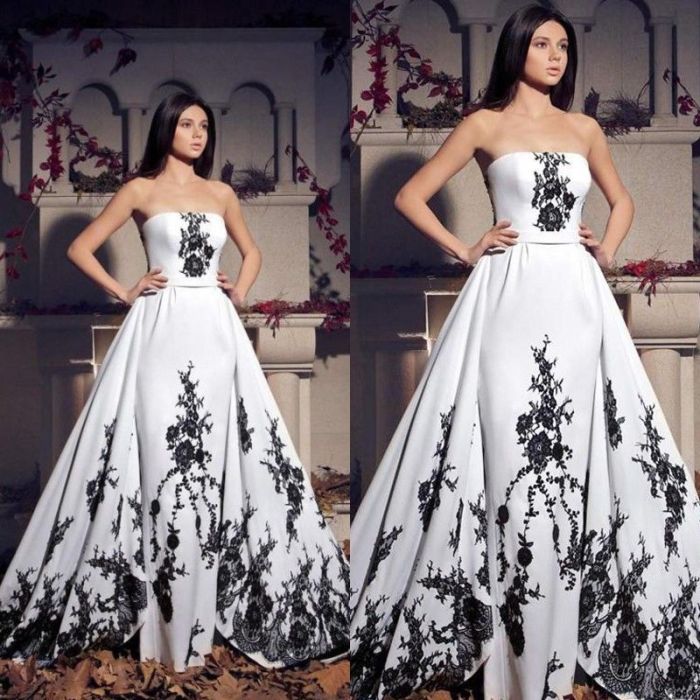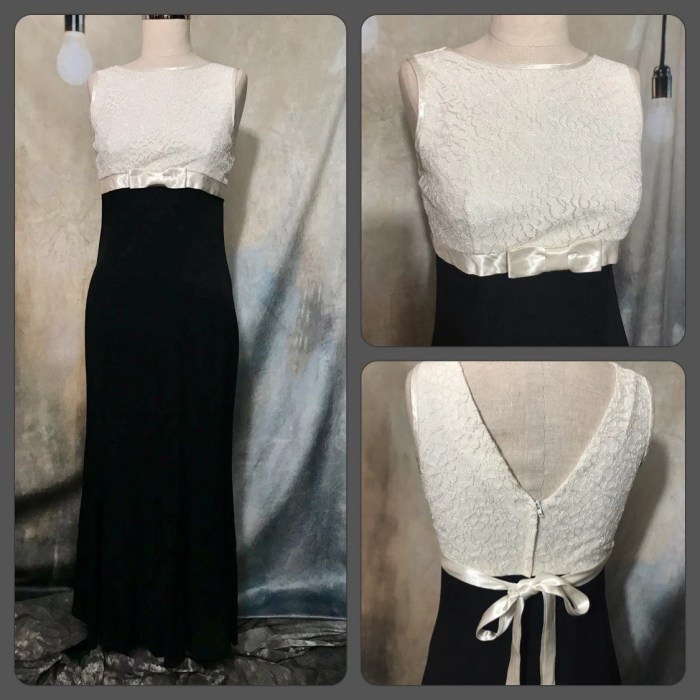Vintage Black and White Wedding Dresses
A Timeless Elegance: Vintage Black and White Wedding Dresses
The allure of vintage black and white wedding dresses transcends time. These gowns, captured in the stark contrast of monochrome photography, offer a glimpse into bygone eras, reflecting societal shifts and evolving fashion trends. From the flapper era’s liberated silhouettes to the post-war era’s romantic flourishes, these dresses tell a story of style, societal influence, and enduring elegance.
Historical Context of Vintage Black and White Wedding Dresses

Source: dhresource.com
The evolution of wedding dress styles in the black and white photography era (roughly the late 19th century to the mid-20th century) is a fascinating journey. Societal norms and economic conditions heavily influenced the choices brides made, resulting in distinct styles for each decade. Fabrics and construction techniques also varied considerably, reflecting both technological advancements and prevailing aesthetics.
The 1920s saw the rise of the flapper dress, characterized by its dropped waistline, shorter length, and beaded embellishments. The Great Depression of the 1930s brought a focus on simpler, more practical styles, often utilizing less expensive fabrics. The 1940s, influenced by wartime rationing, featured more conservative silhouettes with a focus on practicality and resourcefulness. The post-war prosperity of the 1950s ushered in a return to more elaborate styles, often featuring full skirts and intricate detailing.
Iconic films of these eras, such as those featuring Katharine Hepburn or Grace Kelly, showcased these styles beautifully, cementing their place in fashion history. For example, Grace Kelly’s wedding dress, a simple yet elegant gown with long sleeves and a high neckline, epitomized the classic elegance of the 1950s.
Comparing fabrics, we see a shift from heavier silks and satins in earlier decades to the introduction of lighter fabrics like rayon and nylon in later periods. Construction techniques also evolved, with advancements in sewing technology allowing for more intricate details and embellishments.
Design Elements of Vintage Black and White Wedding Dresses
Several common design elements define vintage black and white wedding dresses. Silhouettes, necklines, and embellishments varied across decades, reflecting the prevailing fashion trends. The impact of photography on design choices is also significant, with brides often choosing styles that would photograph well in black and white.
| Decade | Silhouette | Neckline | Common Embellishments |
|---|---|---|---|
| 1920s | Dropped waist, A-line, loose | V-neck, scoop neck, straight across | Beading, sequins, fringe |
| 1930s | Bias cut, fitted bodice, flowing skirt | High neck, sweetheart neckline | Lace, delicate embroidery |
| 1940s | Fitted bodice, full skirt, nipped waist | High neck, sweetheart neckline, off-the-shoulder | Simple embellishments, bows, buttons |
| 1950s | Full skirt, cinched waist, fitted bodice | Sweetheart neckline, boat neck, high neck | Lace, satin, embroidery |
Modern Interpretations of Vintage Black and White Wedding Dresses
Contemporary designers frequently draw inspiration from vintage black and white wedding dresses, adapting classic styles for modern brides. This involves using modern fabrics and techniques while retaining the essence of the original designs.
Many contemporary designers, such as [insert designer names and examples of their work inspired by vintage styles], successfully incorporate vintage elements into their collections. Modern adaptations often involve using lighter, more comfortable fabrics like silk charmeuse or crepe, while maintaining the silhouette and detailing of a vintage design. For example, a modern interpretation of a 1920s flapper dress might feature a dropped waist and beaded embellishments but be made from a more comfortable and breathable fabric.
A modern wedding dress inspired by a 1950s style could incorporate a fitted bodice and full skirt, using modern techniques to create a more comfortable and flattering silhouette. The fabric choice could be a luxurious silk crepe, and the embellishments could be subtle embroidery or delicate lace appliqués, keeping the design elegant and timeless.
The Role of Photography in Showcasing Vintage Black and White Wedding Dresses

Source: etsystatic.com
Black and white photography uniquely enhances the aesthetic appeal of vintage wedding dresses. The absence of color allows the textures, shapes, and details of the dress to stand out, creating a timeless and elegant image. Photographic techniques, such as lighting and composition, play a crucial role in capturing the beauty and elegance of these gowns.
- Example 1: A photograph of a 1930s bias-cut gown, showcasing its flowing silhouette and delicate lace detailing. The soft lighting emphasizes the texture of the fabric, while the composition highlights the elegant lines of the dress.
- Example 2: A portrait of a bride in a 1950s full-skirted gown, captured in a candid pose. The black and white contrast emphasizes the volume of the skirt and the intricate embroidery on the bodice. The photograph’s composition focuses on the bride’s joyful expression, complementing the dress’s romantic appeal.
- Example 3: A close-up shot of a 1920s beaded flapper dress, highlighting the intricate beadwork and the dress’s overall texture. The stark contrast of black and white makes the details pop, creating a striking image.
Preservation and Care of Vintage Black and White Wedding Dresses
Preserving vintage wedding dresses requires careful attention to detail. Delicate fabrics are susceptible to damage from light, moisture, and handling. Proper storage, cleaning, and handling techniques are crucial for maintaining the condition of these precious garments.
Acid-free tissue paper and archival-quality boxes are recommended for storage. Regular inspections for signs of damage and professional cleaning by specialists are also advisable. When handling the dress, it’s important to wear cotton gloves to avoid transferring oils from the skin to the fabric. Displaying the dress should be done in a controlled environment, away from direct sunlight and moisture.
Professional preservation services can offer specialized cleaning, repair, and restoration techniques to maintain the dress’s condition and extend its lifespan.
Top FAQs
What fabrics were commonly used in vintage black and white wedding dresses?
Common fabrics included silk, satin, lace, chiffon, and sometimes even heavier materials like brocade, depending on the decade and style.
How can I find a vintage black and white wedding dress?
Vintage black and white wedding dresses offer a timeless elegance, often featuring intricate details and classic silhouettes. A modern interpretation of this classic style might incorporate the flattering and romantic shape of a sweetheart a-line wedding dress , retaining the monochrome palette but updating the fabric and embellishments for a contemporary feel. Ultimately, the choice reflects personal style, blending old-world charm with modern sensibilities.
You can search online marketplaces like eBay and Etsy, visit antique shops, or check with vintage clothing boutiques specializing in bridal wear.
Are vintage wedding dresses comfortable to wear?
Comfort varies greatly depending on the dress’s age and construction. Some may be more restrictive than modern gowns. Consider alterations or choosing a style that suits your preferences.
How much does a vintage black and white wedding dress typically cost?
Pricing varies significantly based on condition, designer, age, and fabric. Expect a wide range from a few hundred to several thousand dollars.



















